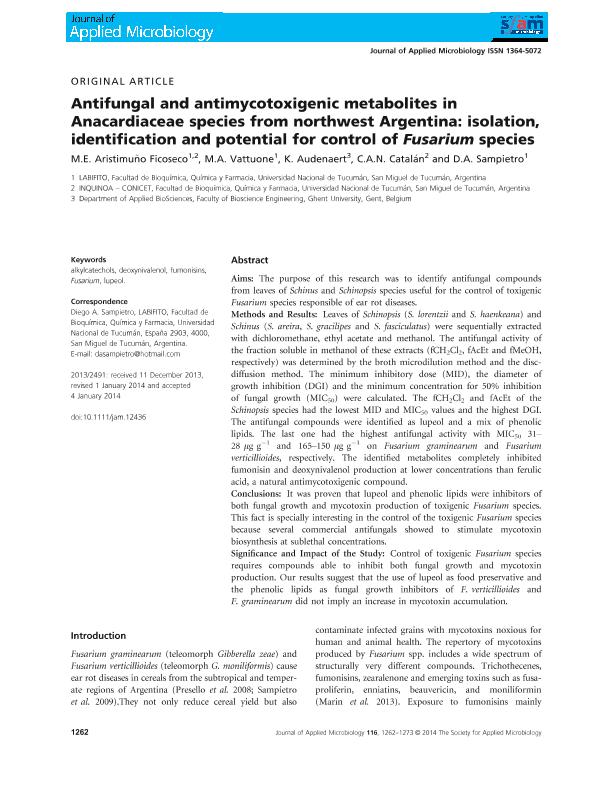Artículo
Antifungal and antimycotoxigenic metabolites in Anacardiaceae species from northwest Argentina: isolation, identification and potential for control of Fusarium species
Aristimuño Ficoseco, Maria Eugenia del Milagro ; Vattuone, Marta Amelia
; Vattuone, Marta Amelia ; Audenaert, K.; Catalan, Cesar Atilio Nazareno
; Audenaert, K.; Catalan, Cesar Atilio Nazareno ; Sampietro, Diego Alejandro
; Sampietro, Diego Alejandro
 ; Vattuone, Marta Amelia
; Vattuone, Marta Amelia ; Audenaert, K.; Catalan, Cesar Atilio Nazareno
; Audenaert, K.; Catalan, Cesar Atilio Nazareno ; Sampietro, Diego Alejandro
; Sampietro, Diego Alejandro
Fecha de publicación:
02/2014
Editorial:
Wiley
Revista:
Journal Of Applied Microbiology
ISSN:
1364-5072
Idioma:
Inglés
Tipo de recurso:
Artículo publicado
Clasificación temática:
Resumen
Aims: The purpose of this research was to identify antifungal compounds from leaves of Schinus and Schinopsis species useful for the control of toxigenic Fusarium species responsible of ear rot diseases. Methods and Results: Leaves of Schinopsis (S. lorentzii and S. haenkeana) and Schinus (S. areira, S. gracilipes and S. fasciculatus) were sequentially extracted with dichloromethane, ethyl acetate and methanol. The antifungal activity of the fraction soluble in methanol of these extracts (fCH2Cl2, fAcEt and fMeOH, respectively) was determined by the broth microdilution method and the discdiffusion method. The minimum inhibitory dose (MID), the diameter of growth inhibition (DGI) and the minimum concentration for 50% inhibition of fungal growth (MIC50) were calculated. The fCH2Cl2 and fAcEt of the Schinopsis species had the lowest MID and MIC50 values and the highest DGI. The antifungal compounds were identified as lupeol and a mix of phenolic lipids. The last one had the highest antifungal activity with MIC50 31– 28 lg g 1 and 165–150 lg g 1 on Fusarium graminearum and Fusarium verticillioides, respectively. The identified metabolites completely inhibited fumonisin and deoxynivalenol production at lower concentrations than ferulic acid, a natural antimycotoxigenic compound. Conclusions: It was proven that lupeol and phenolic lipids were inhibitors of both fungal growth and mycotoxin production of toxigenic Fusarium species. This fact is specially interesting in the control of the toxigenic Fusarium species because several commercial antifungals showed to stimulate mycotoxin biosynthesis at sublethal concentrations. Significance and Impact of the Study: Control of toxigenic Fusarium species requires compounds able to inhibit both fungal growth and mycotoxin production. Our results suggest that the use of lupeol as food preservative and the phenolic lipids as fungal growth inhibitors of F. verticillioides and F. graminearum did not imply an increase in mycotoxin accumulation.
Palabras clave:
Alkylcatechols
,
Deoxynivaleno
,
Fumonisins
,
Fusarium
,
Lupeol
Archivos asociados
Licencia
Identificadores
Colecciones
Articulos(CCT - NOA SUR)
Articulos de CTRO.CIENTIFICO TECNOL.CONICET - NOA SUR
Articulos de CTRO.CIENTIFICO TECNOL.CONICET - NOA SUR
Articulos(INQUINOA)
Articulos de INST.DE QUIMICA DEL NOROESTE
Articulos de INST.DE QUIMICA DEL NOROESTE
Citación
Aristimuño Ficoseco, Maria Eugenia del Milagro; Vattuone, Marta Amelia; Audenaert, K.; Catalan, Cesar Atilio Nazareno; Sampietro, Diego Alejandro; Antifungal and antimycotoxigenic metabolites in Anacardiaceae species from northwest Argentina: isolation, identification and potential for control of Fusarium species; Wiley; Journal Of Applied Microbiology; 116; 5; 2-2014; 1262-1273
Compartir
Altmétricas



